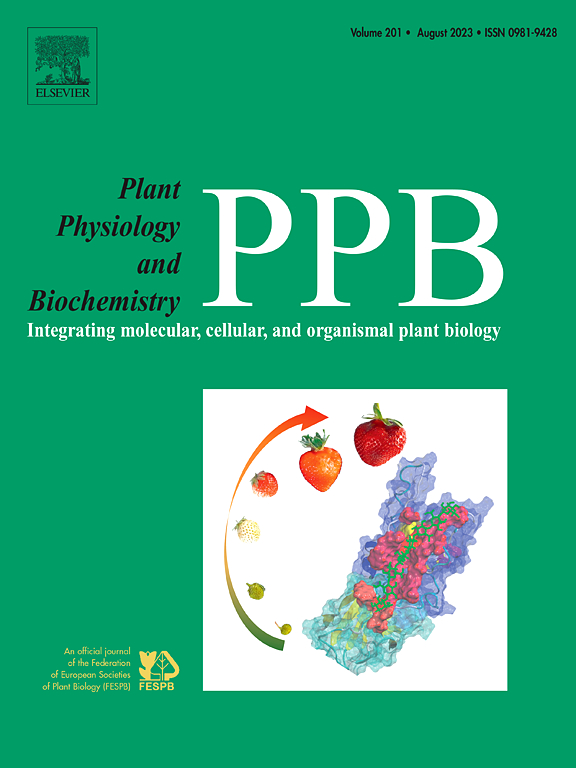Drought-activated BZR1 reprograms flavonoid metabolism via transcriptional cascades to amplify baicalin biosynthesis in Scutellaria baicalensis
IF 5.7
2区 生物学
Q1 PLANT SCIENCES
引用次数: 0
Abstract
Environmental stress triggers a dual response in medicinal plants by inhibiting growth while enhancing secondary metabolite production. However, the regulatory mechanism of this trade-off remains unclear. Here, we identified SbBZR1 as a brassinosteroid (BR)-responsive transcription factor that orchestrates drought resilience and baicalin biosynthesis in Scutellaria baicalensis through integrated multi-omics and metabolic flux analysis. In general, drought stress upregulated BR signaling and SbBZR1 expression. Transgenic Arabidopsis expressing SbBZR1 and its hyperactive mutant (Sbbzr1-1D) exhibited enhanced drought tolerance: 57 % greater biomass, 43 % increased root density, and 62 % reduced lipid peroxidation via antioxidant gene activation (AtDHAR1, AtCAT2, AtSOD1). In S. baicalensis hairy roots, SbBZR1 overexpression increased biomass (68 %) and anthocyanins (2.3-fold), while upregulating flavonoid genes (SbPAL, SbCHS, SbCHI). Under gradient drought, SbBZR1 reprogrammed metabolism dose-dependently: mild stress (1 % PEG) elevated both glycosides (baicalin +128 %) and aglycones (baicalein +196 %), whereas Sbbzr1-1D prioritized glycoside production (3.42-fold baicalin; glycoside-aglycone ratio 15.02 vs. WT 3.93). Mechanistically, Sbbzr1-1D amplified phenylpropanoid flux via SbPAL and SbF8H (4.1–6.3 fold) while suppressing deglycosylation (β-glucuronidase, SbGUS 72 % down-expression). Exogenous epibrassinolide (eBL) treatment confirmed SbBZR1 amplifies BR sensitivity, boosting baicalin yields 2.1–3.8 fold. The BR-SbBZR1 axis dynamically coordinates drought-induced transcriptional bursts (SbFNSII-2, SbF6H) with flavonoid accrual, while differentially regulating glycosylation (SbUBGAT up-expression) and deglycosylation (SbGUS down-expression). Collectively, these results first reveal the transcriptional logic of stress-driven phytochemical enhancement and provide valuable references for engineering drought-resistant crops through precision metabolic regulation.
干旱激活的BZR1通过转录级联重新编程黄酮类代谢,增强黄芩苷的生物合成
环境胁迫在抑制药用植物生长的同时促进次生代谢物的产生,从而引发药用植物的双重反应。然而,这种权衡的监管机制仍不清楚。通过综合多组学和代谢通量分析,我们发现SbBZR1是黄芩中油菜素类固醇(BR)应答转录因子,调控黄芩的抗旱性和黄芩苷的生物合成。总的来说,干旱胁迫上调了BR信号和SbBZR1的表达。表达SbBZR1及其高活性突变体(SbBZR1 - 1d)的转基因拟南芥表现出更强的耐旱性:通过抗氧化基因激活(AtDHAR1, AtCAT2, AtSOD1),生物量增加57%,根密度增加43%,脂质过氧化降低62%。在黄芩毛状根中,SbBZR1过表达增加了生物量(68%)和花青素(2.3倍),上调了类黄酮基因(SbPAL、SbCHS、SbCHI)。在梯度干旱条件下,SbBZR1以剂量依赖性重编程代谢:轻度胁迫(1% PEG)使糖苷(黄芩苷+ 128%)和苷元(黄芩苷+ 1966%)均升高,而SbBZR1 - 1d优先生成糖苷(黄芩苷3.42倍;糖苷-苷元比15.02比3.93)。机制上,Sbbzr1-1D通过SbPAL和SbF8H扩增苯丙素通量(4.1-6.3倍),同时抑制去糖基化(β-葡萄糖醛酸酶,SbGUS下调72%)。外源性表油菜素内酯(eBL)处理证实SbBZR1增强BR敏感性,使黄芩苷产量提高2.1-3.8倍。BR-SbBZR1轴动态协调干旱诱导的转录爆发(SbFNSII-2, SbF6H)与黄酮类化合物的积累,同时差异调节糖基化(SbUBGAT上调表达)和去糖基化(SbGUS下调表达)。综上所述,这些结果首次揭示了胁迫驱动植物化学增强的转录逻辑,为通过精确代谢调控来设计抗旱作物提供了有价值的参考。
本文章由计算机程序翻译,如有差异,请以英文原文为准。
求助全文
约1分钟内获得全文
求助全文
来源期刊
CiteScore
11.10
自引率
3.10%
发文量
410
审稿时长
33 days
期刊介绍:
Plant Physiology and Biochemistry publishes original theoretical, experimental and technical contributions in the various fields of plant physiology (biochemistry, physiology, structure, genetics, plant-microbe interactions, etc.) at diverse levels of integration (molecular, subcellular, cellular, organ, whole plant, environmental). Opinions expressed in the journal are the sole responsibility of the authors and publication does not imply the editors'' agreement.
Manuscripts describing molecular-genetic and/or gene expression data that are not integrated with biochemical analysis and/or actual measurements of plant physiological processes are not suitable for PPB. Also "Omics" studies (transcriptomics, proteomics, metabolomics, etc.) reporting descriptive analysis without an element of functional validation assays, will not be considered. Similarly, applied agronomic or phytochemical studies that generate no new, fundamental insights in plant physiological and/or biochemical processes are not suitable for publication in PPB.
Plant Physiology and Biochemistry publishes several types of articles: Reviews, Papers and Short Papers. Articles for Reviews are either invited by the editor or proposed by the authors for the editor''s prior agreement. Reviews should not exceed 40 typewritten pages and Short Papers no more than approximately 8 typewritten pages. The fundamental character of Plant Physiology and Biochemistry remains that of a journal for original results.

 求助内容:
求助内容: 应助结果提醒方式:
应助结果提醒方式:


